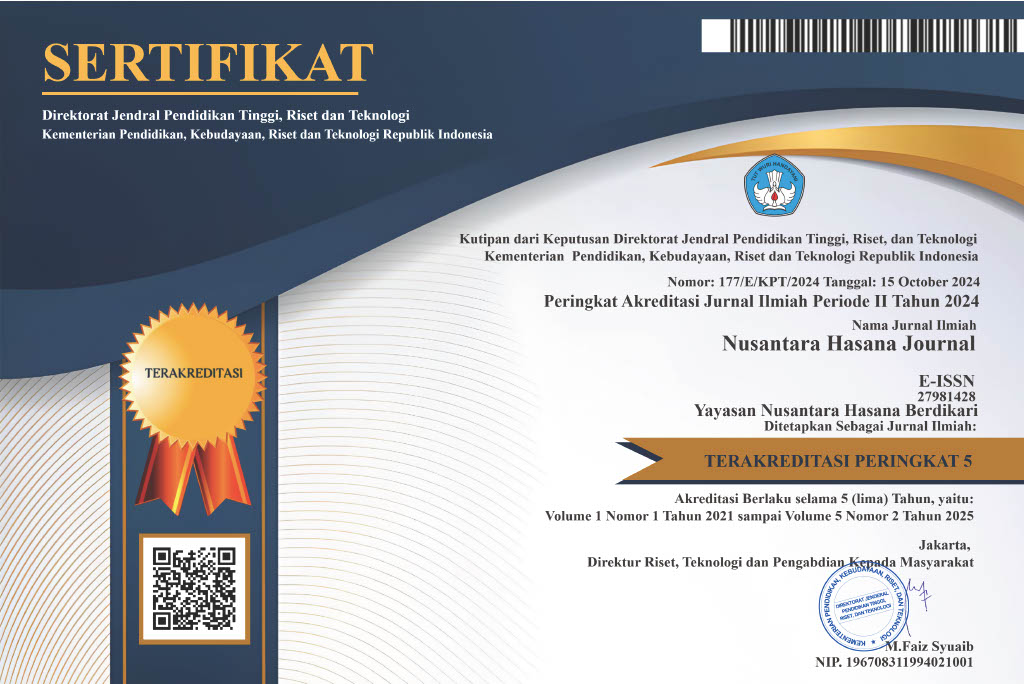STRUCTURAL PERFORMANCE DUE TO ENGINE VIBRATION USING THE LEVELLING TIME HISTORY METHOD
DOI:
https://doi.org/10.59003/nhj.v4i10.1398Keywords:
Structure, Modeling, Earthquake, Machine, Levelling Time HistoryAbstract
In this case study, earthquake is one of the loads that is considered in designing and analyzing buildings. So that the earthquake becomes the author's calculation in analyzing the building against the strength and safety of the structure in receiving earthquake loads that occur with the anticipation of another earthquake history such as the El Centro earthquake. The author aims to analyze the performance of the structure that occurs against earthquake loads, the analysis also pays attention to the level of value that can be achieved by the building nonlinearly, namely the increase in the value of the initial acceleration of the earthquake (Level Aog) that occurred. The analysis is carried out on steel buildings that have bracing, concrete reinforcement, and there are machine activities. Structural performance analysis uses numerical methods and iterations which are assisted by a structural analysis program. The analysis is carried out by defining the hinge on the structural element. The analysis process is carried out in stages with the condition of the machine which is also considered in the leveling time history method. Time history which is also a history of vibration and machine vibration activity adds to the input parameters of the analysis carried out on the building. The response of the building due to engine vibration will be compared with the condition of the building when the engine is off which does not cause vibration. Structural performance analysis is carried out by increasing Aog until the structural elements of the building are no longer able to withstand shear forces and loads that occur when severe damage or conditions are above Collapse Prevention (CP). The results of the structural analysis will produce output in the form of Aog levels with plastic checks with color visuals, deviation checks and rotation checks based on FEMA 356 so as to produce structural strength capabilities. Based on the vibrations that occur with machine activity, the frequency can still be held by the building. The machine vibrations that occur, dampen the vibrations caused by the earthquake so that the leveling indicator becomes larger.
Downloads
References
With a dynamic analysis of time history using ETABS Case Study: Hotels in Karanganyar. Civil Engineering, F. Engineering, Sebelas March University.
Yudi, Ahmad., Nugraha B, Bayzoni, Rijuli. 2019. Analysis of Behavior of Concrete and Steel Structures Using the Levelling Time History Method. Lampung: Sumatra Institute of Technology.
Yudi, Ahmad., Nugraha B, Marudut. 2020. Performance Analysis of Precast Reinforced Concrete Structures Using the Levelling Time History Method (Itera Dormitory Case Study). Lampung: Sumatra Institute of Technology.
Setiawan, Haris B. 2015. Planning of Composite Steel Structure in Hotel-Q Denpasar Bali Building with a Moment Bearer Frame System. Civil Engineering, F. Engineering, University of Jember.
FEMA-356. 2000. Prestandard and Commentary For The Seismic Rehabilitation Of Buildings. Virginia. American Society of Civil Engineers.
Budiono, Bambang and Lucky Supriatna. 2011. Comparative Study of Earthquake-Resistant Building Design. Bandung: Bandung Institute of Technology, ISBN.
Pujianto, A. (2011). Composite Structure Using the LRFD Method: MIT Press. https://ekhalmussaad.files.wordpress.com/2011/03/7-komposit.doc. (accessed July 10, 2021)
Ulfah, Atika. 2011. Evaluation of the Performance of the Structure of the Sardjito Public Lecture Building. Master of Civil Engineering, Islamic University of Indonesia. Yogyakarta.
SNI 1726:2019, 2019, Procedures for Earthquake Resistance Planning for Building and Non-Building Structures. Indonesian Standardization Agency, Jakarta.
SNI 1727:2020, 2020, Minimum Loads For the Planning of Buildings and Other Structures. Indonesian Standardization Agency, Jakarta.
SNI 2847: 2019, 2019. Structural concrete requirements for building buildings. Indonesian Standardization Agency, Jakarta.
SNI 1729: 2020, 2020. Specifications for Structural Steel Building Buildings. Indonesian Standardization Agency, Jakarta.
BachMann, Hugo. "Vibrations In Structure Induced by Man and Machines" Ebook. Zurich, Switzerland. IABSE-AIPC-IVBH.
Setiawan. Arman. (2014). Study of Collapse due to cyclic load using pushover analysis method on portal.
Sugito, (2007). "Static and Dynamic 3D Analysis" SAP 2000 Module.
Lakhdar, Missoum., Djermane Mohammed, et al. (2013). Damages detection in a composite structure by vibration analysis.
Listyorini. 2015. Evaluation of Building Structure Performance with Time History Analysis (Case Study: Bethesda Hospital Building, Yogyakarta). Department of Civil Engineering, Sebelas March University.
Masbudi, Edy Purwanto, Agus Supriyadi. 2015. Evaluation of Building Structural Performance with Pusover Analysis (Case Study: Integrated Central Surgery Building, Bethesda Hospital Yogyakarta). Department of Civil Engineering, Sebelas March University.
Downloads
Published
How to Cite
Issue
Section
License
Copyright (c) 2025 Ahmad Yudi

This work is licensed under a Creative Commons Attribution-NonCommercial-ShareAlike 4.0 International License.
NHJ is licensed under a Creative Commons Attribution-NonCommercial-ShareAlike 4.0 International License.
Articles in this journal are Open Access articles published under the Creative Commons CC BY-NC-SA License This license permits use, distribution and reproduction in any medium for non-commercial purposes only, provided the original work and source is properly cited.
Any derivative of the original must be distributed under the same license as the original.
























